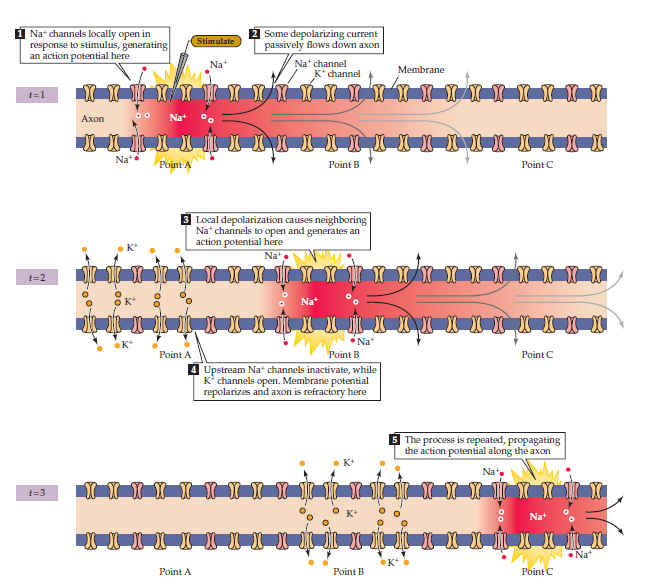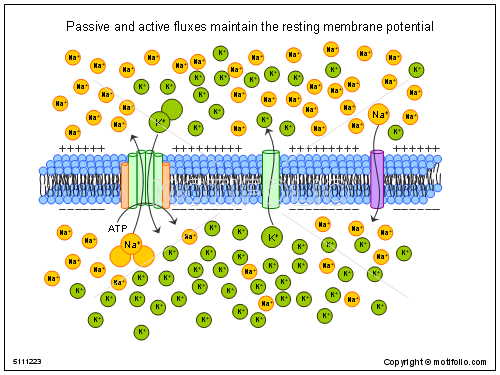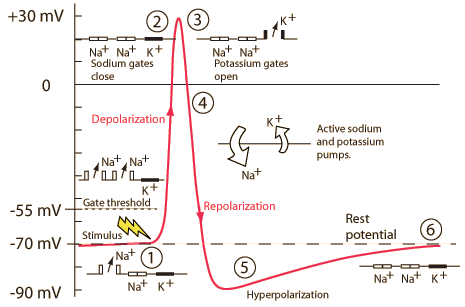Nerves are just like wires aren’t they?
Electrical impulses move through neurones just like electricity flows through a wire, right?
No! Absolutely not. Nerves are commonly described as wires as an analogy to simplify their function, but it does not in any way describe how they actually work. The only similarity between wires and nerves is that there is a flow of charge. However, with a wire, there is a flow of electrons through the conducting metal. This is certainly not the case with a nerve.

figure 1. Representation of a nerve cell conducting impulses
So, how do nerves conduct electrical impulses then?
It is all to do with ions. The movement of ions through channels across a membrane to be more specific. But, before we can hope to understand how impulses propagate along an active nerve axon, we must first understand the cell at rest. This is known as the resting potential
What is a resting potential?
All cells have a resting potential. It is simply the charge of the inside of the cell with respect to the outside of the cells. The resting potential of a nerve cell is around -70mV. All that means is the inside of the cell has -70mV charge with respect to the outside of the cell.
How does the resting potential arise?
Ions and channels! I am going to explain this phenomenon using the example of the nerve cell.
The cell has a very high concentration of potassium ions (K+) inside the cell, and a very high concentration of sodium ions (Na+) outside the cell. Thus, with the K+ ions will tend to move outside the cell, while the Na+ ions will want to move into the cell. This is just common diffusion stuff down concentration gradients. Since both of the ions are positive, eventually they will not be able to continue to move into the place where there is a lower concentration of ions due to the repulsion of their positive charge, and an equilibrium will be reached.
Each ion has a specific value for the voltage at which this equilibrium is reached, depending on the concentration of ions inside and outside the cell. It is called a Nernst potential
The nerve cell is far more permeable to K+ than Na+, meaning more positive charges will leave the cell, than those entering the cell. This makes the inside of the cell more negative, giving us the resting potential value of -70mV. A visual representation of a resting potential is shown in figure 2.
Now we are finally reading to tackle the nerve impulses and how they travel. This is down to depolarisation of the resting potential in response to a stimulus. This is known as an action potential. This is shown in figure 3 and the stages are described below.
Stage 1 = resting potential
Stage 2 = depolarisation in response to a stimulus. The stimulus causes voltage gated Na+ channels to open causing Na+ to move from outside to inside the cell (down its concentration gradient). Remember Na+ is in high concentration outside the cell. This makes the membrane become positive (around -30mV)
Stage 3 = Na+ channels close and K+ channels open in response to depolarisation
Stage 4 = repolarisation. Voltage gated K+ channels are now open and K+ move from inside the cell to outside the cell down its concentration gradient. This will bring the cell back to resting potential
Stage 5 = hyperpolarisation. The K+ channels are open too long and the voltage overshoots, woops!
Stage 6 = finally, resting potential again.
But how do the action potentials travel along the cell?
Thankfully, this is the simplest part. The channels mentioned above are voltage gated. This means if a stimulus is above the threshold for a specific nerve the voltage gated Na+ channels will be triggered to open. Once depolarisation in one place has a occurred, the disruption in membrane potentials triggers the next segment of the membrane to be depolarised and the next voltage gated Na+ channel to open. In this way the impulse travels along the nerve. Not by ions moving through the cell, but by a series of ions moving across the membrane and disrupting the voltages. This is seen in figure 4.

figure 4. Propagation of an action potential
If you are reading this, you made it! You have conquered nerve cells! The physiology of nerves and action potentials is extremely complicated, so I have tried to summarise it as simply as I can. I hope you have enjoyed reading it.
References:
https://en.wikipedia.org/wiki/Resting_potential
http://www.physiologyweb.com/lecture_notes/resting_membrane_potential/resting_membrane_potential_nernst_equilibrium_potential.html
https://www.khanacademy.org/test-prep/mcat/organ-systems/neuron-membrane-potentials/a/neuron-action-potentials-the-creation-of-a-brain-signal
http://hyperphysics.phy-astr.gsu.edu/hbase/Biology/actpot.html


Thanks for the very informative post!!
No problem, thanks for reading.
Congratulations @ovij! You have completed some achievement on Steemit and have been rewarded with new badge(s) :
Click on any badge to view your own Board of Honor on SteemitBoard.
For more information about SteemitBoard, click here
If you no longer want to receive notifications, reply to this comment with the word
STOPThis gem of a post was discovered by the OCD Team!
Reply to this comment if you accept, and are willing to let us promote your gem of a post!
If you accept this, you'll be nominated and the members of the OCD team will vote on whether we'll feature your post in our next compilation post.
You can follow @ocd – learn more about the project and see other Gems! We strive for transparency.
I'm mostly curating in #science and am always glad to see quality posts like yours peeking out between the garbage and plagiarism!
Thank you very much, you are more than welcome to use this for OCD.
Hey man nice post
Id like to nominate it in the OCD curation group
This gem of a post was discovered by the OCD Team!
Reply to this comment if you accept, and are willing to let us share your gem of a post! By accepting this, you have a chance to receive extra rewards and one of your photos in this article may be used in our compilation post!
You can follow @ocd – learn more about the project and see other Gems! We strive for transparency.
Thanks you so much, you are welcome to use this post for OCD.
ah didnt notice suesa already found this one she will nominate you
See, I always thought of them as wires. Having MS, I always thought of nerves as wires, with the attacked myelin sheath being the insulator for the charge or signal. Thank you for the explanation, happy to learn more each day.
Thinking of a nerve as a wire can be useful in understanding what they do, but not how they do it! The myelin sheath does insulate a neurone, but it's main function is to increase the speed of conduction of impulses along the neurone. This is why demyelination can have bad effects, it slows down the speed at which nerves conduct!
Thank you for that. I'm learning more each day.
It's good but I'm not going to upvote because you spammed me in the chat
Well at least you read it! I am glad that you enjoyed reading it, which is the main thing for me.
Thank you very much for recognising my post, much appreciated.
Congratulations @ovij! You have completed some achievement on Steemit and have been rewarded with new badge(s) :
Click on any badge to view your own Board of Honor on SteemitBoard.
For more information about SteemitBoard, click here
If you no longer want to receive notifications, reply to this comment with the word
STOPCongratulations @ovij! You have completed some achievement on Steemit and have been rewarded with new badge(s) :
Click on any badge to view your own Board of Honor on SteemitBoard.
For more information about SteemitBoard, click here
If you no longer want to receive notifications, reply to this comment with the word
STOPCongratulations @ovij! You have completed some achievement on Steemit and have been rewarded with new badge(s) :
Click on any badge to view your own Board of Honor on SteemitBoard.
For more information about SteemitBoard, click here
If you no longer want to receive notifications, reply to this comment with the word
STOPThis was really interesting and I really enjoyed reading and learning! :)